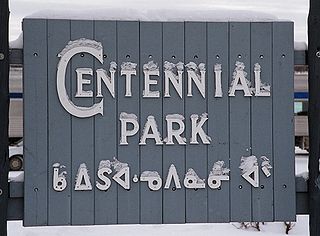
In linguistics, specifically phonetics and phonology, schwa is a vowel sound denoted by the IPA symbol ⟨ə⟩, placed in the central position of the vowel chart. In English and some other languages, it usually represents the mid central vowel sound, produced when the lips, tongue, and jaw are completely relaxed, such as the vowel sound of the ⟨a⟩ in the English word about.

The Mosquito Coast is the area along the eastern coast of present-day Nicaragua and Honduras. It was named after the local Miskito Nation and was long dominated by British interests and known as the Mosquito Kingdom. From 1860 suzerainty of the area was transferred to Nicaragua with the name Mosquito Reserve, and in November 1894 the Mosquito Coast was militarily incorporated into Nicaragua. However, in 1960, the northern part was granted to Honduras by the International Court of Justice.

Wyandot is the Iroquoian language traditionally spoken by the people known as Wyandot or Wyandotte, descended from the Tionontati. It is considered a sister to the Wendat language, spoken by descendants of the Huron-Wendat Confederacy. It was last spoken, before its revival, by members located primarily in Oklahoma, United States, and Quebec, Canada. Linguists have traditionally considered Wyandot as a dialect or modern form of Wendat.
The phonology of Portuguese varies among dialects, in extreme cases leading to some difficulties in intelligibility. Portuguese is a pluricentric language and has some of the most diverse sound variations of any language. This article on phonology focuses on the pronunciations that are generally regarded as standard. Since Portuguese is a pluricentric language—and differences between European Portuguese (EP), Brazilian Portuguese (BP), and Angolan Portuguese (AP) can be considerable—varieties are distinguished whenever necessary.

The Muscogee language, previously referred to by its exonym, Creek, is a Muskogean language spoken by Muscogee (Creek) and Seminole people, primarily in the US states of Oklahoma and Florida. Along with Mikasuki, when it is spoken by the Seminole, it is known as Seminole.
The Portuguese language developed in the Western Iberian Peninsula from Latin spoken by Roman soldiers and colonists starting in the 3rd century BC. Old Portuguese, also known as Medieval Galician, began to diverge from other Romance languages after the fall of the Western Roman Empire and the Germanic invasions, also known as barbarian invasions, in the 5th century, and started appearing in written documents around the 9th century. By the 13th century, Galician-Portuguese had its own literature and began to split into two languages. However, the debate of whether Galician and Portuguese are nowadays varieties of the same language, much like American English or British English, is still present. In all aspects—phonology, morphology, lexicon and syntax—Portuguese is essentially the result of an organic evolution of Vulgar Latin with some influences from other languages, namely the native Gallaecian and Lusitanian languages spoken prior to the Roman domination.

The Misumalpan languages are a small family of languages spoken by indigenous peoples on the east coast of Nicaragua and nearby areas. The name "Misumalpan" was devised by John Alden Mason and is composed of syllables from the names of the family's three members Miskito, Sumo languages and Matagalpan. It was first recognized by Walter Lehmann in 1920. While all the languages of the Matagalpan branch are now extinct, the Miskito and Sumu languages are alive and well: Miskito has almost 200,000 speakers and serves as a second language for speakers of other indigenous languages in the Mosquito Coast. According to Hale, most speakers of Sumu also speak Miskito.
In an alphabetic writing system, a silent letter is a letter that, in a particular word, does not correspond to any sound in the word's pronunciation. In linguistics, a silent letter is often symbolised with a null sign U+2205∅EMPTY SET. Null is an unpronounced or unwritten segment. The symbol resembles the Scandinavian letter Ø and other symbols.

Cayuga is a Northern Iroquoian language of the Iroquois Proper subfamily, and is spoken on Six Nations of the Grand River First Nation, Ontario, by around 240 Cayuga people, and on the Cattaraugus Reservation, New York, by fewer than 10.
The Guarani alphabet (achegety) is used to write the Guarani language, spoken mostly in Paraguay and nearby countries. It consists of 33 letters.

Belizean Creole is an English-based creole language spoken by the Belizean Creole people. It is closely related to Miskito Coastal Creole, San Andrés-Providencia Creole, and Jamaican Patois.

Ojibwe is an indigenous language of North America from the Algonquian language family. Ojibwe is one of the largest Native American languages north of Mexico in terms of number of speakers and is characterized by a series of dialects, some of which differ significantly. The dialects of Ojibwe are spoken in Canada from southwestern Quebec, through Ontario, Manitoba and parts of Saskatchewan, with outlying communities in Alberta and British Columbia, and in the United States from Michigan through Wisconsin and Minnesota, with a number of communities in North Dakota and Montana, as well as migrant groups in Kansas and Oklahoma.

The Mayangna are a people who live on the eastern coasts of Nicaragua and Honduras, an area commonly known as the Mosquito Coast. Their preferred autonym is Mayangna, as the name "Sumo" is a derogatory name historically used by the Miskito people. Their culture is closer to that of the indigenous peoples of Costa Rica, Panama, and Colombia than to the Mesoamerican cultures to the north. The Mayangna inhabited much of the Mosquito Coast in the 16th century. Since then, they have become more marginalized following the emergence of the Miskito as a regional power.

Portuguese orthography is based on the Latin alphabet and makes use of the acute accent, the circumflex accent, the grave accent, the tilde, and the cedilla to denote stress, vowel height, nasalization, and other sound changes. The diaeresis was abolished by the last Orthography Agreement. Accented letters and digraphs are not counted as separate characters for collation purposes.
The Miskito language, the language of the Miskito people of the Atlantic coast of Nicaragua and Honduras, is a member of the Misumalpan language family and also a strongly Germanic influenced language. Miskito language is widely spoken in Honduras and Nicaragua as Spanish, it is also an official language in the Atlantic region of these countries. With more than 8,000,000 speakers, Miskito has positioned in the second place in both countries after Spanish. Miskito is not only spoken in Central America, but in Europe, USA, Canada and in many other Latin American countries there are Miskitos who made their lives and maintain their culture and language alive. Miskito used to be a royal state language.
The phonology of Sesotho and those of the other Sotho–Tswana languages are radically different from those of "older" or more "stereotypical" Bantu languages. Modern Sesotho in particular has very mixed origins inheriting many words and idioms from non-Sotho–Tswana languages.

The official language of Nicaragua is Spanish; however, Nicaraguans on the Caribbean coast speak indigenous languages and also English. The communities located on the Caribbean coast also have access to education in their native languages. Additionally, Nicaragua has four extinct indigenous languages.
Hindustani is the lingua franca of northern India and Pakistan, and through its two standardized registers, Hindi and Urdu, a co-official language of India and co-official and national language of Pakistan respectively. Phonological differences between the two standards are minimal.
Nepali is the national language of Nepal. Besides being spoken as a mother tongue by more than 48% of the population of Nepal, it is also spoken in Bhutan and India. The language is recognized in the Nepali constitution as an official language of Nepal.
The Miskito Sambu, also known simply as the Miskito, are an ethnic group of mixed cultural ancestry occupying a portion of the Caribbean coast of Central America known as the Mosquito Coast region. Although older records, beginning with Spanish documents of the early 18th century, refer to the group as "Mosquitos Zambos", modern ethnographic terminology uses the term Miskito.











